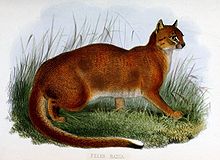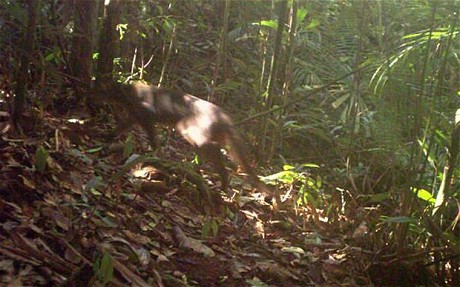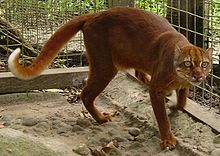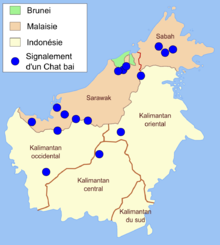“Extinct” Cat Spotted
Posted by: Loren Coleman on January 13th, 2011

Breaking news out of Malaysia is that an extinct felid species has been spotted, leading to speculation that it has been rediscovered. The beautiful cat is one of the smaller wild cats, but the finding of it is no less remarkable than the appearance of other midsized new species.

Ian MacKinnon of The Telegraph in London is reporting that the Bornean Bay Cat, last photographed in 2003 in Lanjak Entimau wildlife sanctuary in southern Sarawak, and declared extinct, has been spotted again.
“Three pictures showing two or three of the Bay Cats were taken [in 2009 and 2010, but just released] in the northern highlands of Sarawak state in Borneo by researchers working for the forestry department,” noted MacKinnon.
The Bornean Bay Cat (Catopuma badia), also known as Bornean Cat, Bornean Red Cat, Bornean Marbled Cat, Borneo-katze, Chat Bai, Gato Rojo de Borneo, Kucing Kalimantan, Kucing Merahor or Bay Cat, is a small feline endemic to the island of Borneo. The Bay Cat and the Asian Golden Cat (Catopuma temminckii) are the only members of the genus Catopuma.
Nearly everything that is known about this cat is based on just twelve specimens, the first of which was collected by Alfred Russel Wallace in 1855 in Sarawak. A total of seven further skins surfaced over the following decades, but it was not until 1992 that a living specimen was obtained, and there were no photographs of the animal until a second living specimen was captured in 1998.

Photo by Jim Sanderson, via Wikipedia.
Despite what the Telegraph says about the cat being “extinct,” the Bay Cat has been only recently reclassified as “endangered” by the IUCN in 2005, after being classified “data deficient” only ten years before. Now that the cat is fully protected over most of its range, CITES has recently placed the Bornean Bay Cat on Appendix II, due to lack of data. There are only fifty known to be left in the world.

Although on paper Borneo has 25 wildlife reserves, only three are actually in existence, with the others only proposed. All of these reserves have been encroached upon by human settlement and logging. Unfortunately local trappers and animal dealers are also well aware that foreign zoos and breeding facilities will pay US $10,000 or more for a live animal. There are no Bay Cats officially in captivity.
About Loren Coleman
Loren Coleman is one of the world’s leading cryptozoologists, some say “the” leading living cryptozoologist. Certainly, he is acknowledged as the current living American researcher and writer who has most popularized cryptozoology in the late 20th and early 21st centuries.
Starting his fieldwork and investigations in 1960, after traveling and trekking extensively in pursuit of cryptozoological mysteries, Coleman began writing to share his experiences in 1969. An honorary member of Ivan T. Sanderson’s Society for the Investigation of the Unexplained in the 1970s, Coleman has been bestowed with similar honorary memberships of the North Idaho College Cryptozoology Club in 1983, and in subsequent years, that of the British Columbia Scientific Cryptozoology Club, CryptoSafari International, and other international organizations. He was also a Life Member and Benefactor of the International Society of Cryptozoology (now-defunct).
Loren Coleman’s daily blog, as a member of the Cryptomundo Team, served as an ongoing avenue of communication for the ever-growing body of cryptozoo news from 2005 through 2013. He returned as an infrequent contributor beginning Halloween week of 2015.
Coleman is the founder in 2003, and current director of the International Cryptozoology Museum in Portland, Maine.










This story reminds me very much in many ways of the plights of the critically endangered Iriomote wildcat and the Tsushima wildcat of Japan. In both cases we have a species of small to mid-size cat in island habitats with similar remaining numbers, and in both cases we have species being classified fairly recently. Also, in both cases we know very little about their habits and behaviors. It even looks as though their habitats are remarkably similar.
In the case of the Japanese cats, a major, major threat is roadways. Cars kill more of the cats than anything else, and the more settlements, the more roads. I wonder if this is a similar threat with these Bay Cats.
Concerning wildlife preserves, these preserves are only useful if they are situated where the cats actually are. On Iriomote Island in Japan, there are wildlife preserves, but they are in areas that are not favored by the cats they are trying to protect. They tend to be in the deep interior of the island, when these cats prefer the coastal areas, which wouldn’t you know, are also the most popular with tourists (those roads again).
Cats also tend to have large territories and can wander over very wide ranges, which may not be within the confines of a wildlife preserve. So you can have all of the preserves you want, but the cats have t be there to be protected by them. In this case, it seems to me that in order to effectively implement a preservation plan, more research is going to have to be done on these cats;their behavior, their habits, and where they are.
Good report Loren. I’d first read about the ‘discovery’ in a recent article on Science Daily, and it didn’t put the discovery in the same contex, so your perspective is appreciated, as are Mystery Man’s comments above. I too thought naturally about the island geography and these radiating species of cats similar to what Mystery Man’s recent series of reports covered. It would make sense they are all adapted to coastal living more than some other species. No doubt a genetic history will reveal more about how these populations came to be and what similarities and difference we can infer, and like Mystery Man says, come up with a better plan to protect their habitat and few remaining individuals wherever they occur. Though, when a species is this elusive I have to wonder just how confident we can be in estimates of their population. I would presume that those numbers are derived following some fairly well established but never-the-less hard-to-verify mathmatical/statistical projection formulas which are themselves dependent on what is likely pretty slim and anecdotal data. So maybe they are quite a few more than we estimate, but I wouldn’t want to bet on that.
Dogu4- Just saw your comment and thought I could shed some light on how they come up with some of these population estimates.
There are a great variety of methods used in coming up with wildlife population estimates, depending on a range of factors such as the species, the habitat, and how much funding and manpower you are willing to throw into it, however there are 4 general ways of getting a consensus; total counts, incomplete counts, indirect counts, and mark-recapture.
A total count is pretty straightforward, and involves counting every single specimen of a population, through an array of different methods. This is often impractical or even impossible, since it is cost and personnel intensive and does not lend itself well to remote or difficult to reach habitats.
An incomplete count also can be used to describe a variety of techniques but in this case the basic gist is you are trying to count part of the population and then using that data to extrapolate the size of the population. So in the case of something like these cats, you could get an idea of the territory and range of the animals and use that information to extrapolate the population size based on the island size and a partial count of the individuals. Also, sometimes when little is known about a species, population data is used from a similar species to compensate. So using what we know about other similar sized cats in similar habitats to sort of fill in the blanks. Obviously this is not as accurate as a total count, especially when we are dealing with a little understood, mysterious cat like these Bay Cats.
Then there are indirect counts. Again, a variety of methods fall into this category, but it basically entails using indirect visual or audio signs of animals as indices of abundance. This could cover any number of signs such as scat, dens or nests, kills, hair samples, calls, and so on. The data from the signs found is used to extrapolate an index of abundance. This method is especially useful for elusive animals or animals in extremely remote habitats or rugged places where it is difficult to employ other census techniques. This method is not conducive to reaching an accurate estimate, but you can get a ball park figure.
Then there is mark-recapture methods, which basically involves tagging and releasing specimens and then using the data obtained to determine the ratio of marked versus unmarked animals.
In the case of an animal as elusive as these Bay Cats seem to be, it is difficult to say for certain how many they are down to the last animal, but using a variety of techniques such as I explained above biologists can come to some ball park estimates. With an animal as reclusive and lacking in data as these Bay Cats seem to be, the population could absolutely be different than what is stated, but I would say the population probably wouldn’t be too dramatically different either way.
These cats are probably in pretty big trouble along the lines of what the estimates say and this is worrying because that means each one that dies has a major impact on the health of the species as a whole. Not only does a cat hit by a car dramatically reduce the number of animals (when taking into account reproductive rates of course), but in a population this size it means a smaller overall gene pool. The effects of an individual dying are greatly magnifies at these numbers.
Anyway, didn’t really intend for such a long post, but hope this information is helpful.